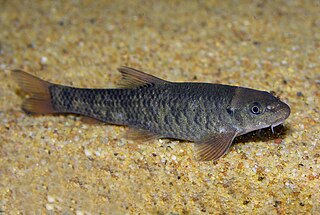
Formica is a genus of ants of the subfamily Formicinae, including species commonly known as wood ants, mound ants, thatching ants, and field ants. Formica is the type genus of the Formicidae, and of the subfamily Formicinae. The type species of genus Formica is the European red wood ant Formica rufa. Ants of this genus tend to be between 4 and 8 mm long. Ants belonging to the Formica genus possess a single knob or bump located between their thorax and abdomen. These ants primarily feed on honeydew, a sugary liquid produced by aphids. Formica ants appear to take on a shepherding role with smaller aphids, relocating them to different parts of plants to ensure a continuous food source for the aphids. By doing so, the ants can establish a relatively sustainable honeydew supply for both themselves and their colony.

The African darter (Anhinga rufa), sometimes called the snakebird, is a water bird of sub-Saharan Africa and Iraq.

The red garra, also known as the doctor fish or nibble fish, is a species of cyprinid that is native to a wide range of freshwater habitats in subtropical parts of Western Asia. This small fish typically is up to about 14 centimeters in total length, but locally individuals can reach as much as 24 cm (9.5 in).

The mountain beaver is a North American rodent. It is the only living member of its genus, Aplodontia, and family, Aplodontiidae. It should not be confused with true North American and Eurasian beavers, to which it is not closely related; the mountain beaver is instead more closely related to squirrels, although its less-efficient renal system was thought to indicate greater relative antiquity for the species. There are seven subspecies of mountain beavers, six of which are found in California and three of which are endemic to the state.

The Bornean crested fireback is a medium-sized forest pheasant from Borneo and the Bangka Belitung Islands. It is the type species of the genus Lophura. Prior to 2023, it was referred to as simply the crested fireback as the Malayan crested fireback was lumped with this species, though both have since been split.

The rufous owl, also known as the rufous boobook, is a species of owl in the family Strigidae. It was described in 1846 by John Gould, an English ornithologist. Its common name reflects the rufous-coloured feathers that these owls are covered with in adulthood. While it is uncommon, the species has a wide range, including Australia, Indonesia, and Papua New Guinea.
Lachesilla rufa is a species of fateful barklouse in the family Lachesillidae. It is found in North America.

Rhysothorax is a genus of dung beetles in the family Scarabaeidae, containing only one species, R. rufus. It has at times been classified as a subgenus within Aegialia.
Panorpa floridana, the Florida scorpionfly, is a species of common scorpionfly in the family Panorpidae. It has only been found in two Florida counties, Clay and Alchua. Described as "cryptic" it is quite handsome in a buggy way.
Heliaula is a genus of slant-faced grasshoppers in the family Acrididae. There is one described species in Heliaula, H. rufa.

Zaitzevia is a genus of riffle beetles in the family Elmidae. There are about 19 described species in Zaitzevia. The genus is named after the Russian entomologist Filipp Zaitsev.
Automola is a genus of flies in the family Richardiidae. There are at least three described species in Automola.

Strabala rufa is a species of flea beetle in the family Chrysomelidae. It is found in North America.
Isonychia rufa is a species of brushlegged mayfly in the family Isonychiidae and the bicolor group. It was originally named by McDunnough in 1931. It is found in central North America, from southern Manitoba to Oklahoma. Isonychia rufa is commonly found in larger rivers and streams from the Mississippi drainage. Isonychia rufa can be distinguished from other species in the bicolor group through certain characteristics present in male imago. These include: whiteish and light yellowish veins in the forewing hyaline, dorsal penes with a relatively prominent basal swelling which forms lateral and apical ridges, bright red to reddish orange brown abdomen, and stigmatic cross veins.

Psilotreta rufa is a species of mortarjoint casemaker in the family Odontoceridae. It is found in North America.

Epuraea rufa is a species of sap-feeding beetle in the family Nitidulidae. It is found in North America.

Eris rufa is a species of jumping spider. It is found in the United States.
Cephalonomia is a genus of parasitoid wasps in the family Bethylidae. There are more than 20 described species in Cephalonomia.

Anaspis rufa is a species of false flower beetle in the family Scraptiidae. It is found in North America.

Plateumaris rufa is a species of aquatic leaf beetle in the family Chrysomelidae. It is found in the eastern United States and Canada, from West Virginia north to Quebec. It was first described in 1826 by Thomas Say based on a specimen found on the bank of the Schuylkill River in Pennsylvania. The species has variable coloration. Although it is typically metallic reddish copper, it is sometimes blue, green, or rarely purple. Its appendages are rufous.













